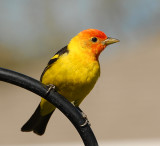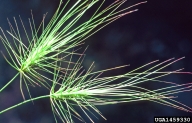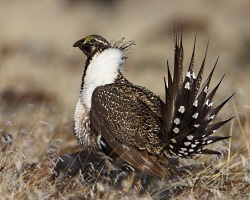
Courtesy & Copyright © 2010
Michael Fish
For many of us, the day has not truly begun until we hold a warm mug of richly flavored coffee in our hands. But how often have you considered where that coffee comes from and how its culture impacts wild Utah?
We tend to think of migratory birds as our residents who take a winter vacation to the south every year. But it is more truly the other way around. They are representatives from groups of tropical birds who venture north to take advantage of less crowded nesting and a seasonal abundance of food for their young. For instance, of the 49 species of true tanagers, only 4 summer in the United States. Much of our coffee originates in Central and South America and its production directly affects birds who fly north to nest in Utah.
Traditionally, coffee bushes are grown under a diverse canopy. Some of the trees in the overstory yield timber, others fix nitrogen and still others like papaya provide food. This multi-tiered habitat supports a wide variety of birds that is only exceeded by undisturbed tropical forest itself.
About twenty years ago, coffee production changed radically with the development of varieties that tolerate full sun. This has allowed huge areas of land to be cleared of forest and planted exclusively to row after row of coffee bushes that demand intensive management. More fertilizer and pesticides are needed leading to toxic runoff. Soil erosion increases. Much lovely bird habitat has been destroyed for this barren coffee monoculture. Many migratory bird populations are in trouble due to the loss of their forested winter habitats.
But there is hope for coffee lovers because many farmers still grow coffee in the traditional way. These grower-owned farms tend to be smaller and provide a more reliable income for the farmer due to the diversity of crops. Soil quality is maintained while providing critical habitat for tropical frogs, insects, plants and birds. When purchasing coffee, look for bird friendly or shade grown or certification by Rainforest Alliance or Smithsonian. Our warblers, tanagers and thrushes will thank you.
This is Linda Kervin for Bridgerland Audubon Society.
Credits:
Images: Courtesy & Copyright Michael Fish
Text: Linda Kervin, Bridgerland Audubon Society
Additional Reading:
Shade-Grown Coffee, National Audubon Website, https://web4.audubon.org/bird/at_home/coffee/
Song Bird Coffee, American Birding Association, https://www.aba.org/shadecoffee/songbird.html
Some Coffee-related Resources, American Birding Association, https://www.aba.org/shadecoffee/whattodo.html#Coffee-related%20Resources
Why Migratory Birds are Crazy for Coffee, Migrants and Coffee: What’s the Connection?, National Zoo, Smithsonian Institution, https://nationalzoo.si.edu/scbi/MigratoryBirds/Fact_Sheets/default.cfm?fxsht=1
Why Migratory Birds Are Crazy for Coffee, Atlanta Audubon Society, formerly: https://atlantaaudubon.org/aaswww/sgc/sgcfacts.htm
Smithsonian-Certified Shade Grown & Bird Friendly Coffee, Caffe Ibis, https://caffeibis.com/






